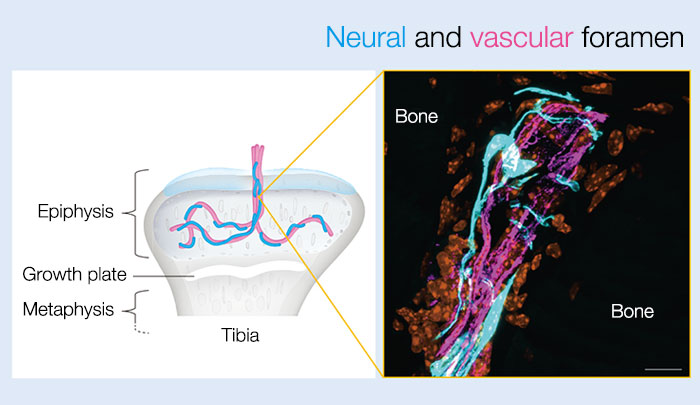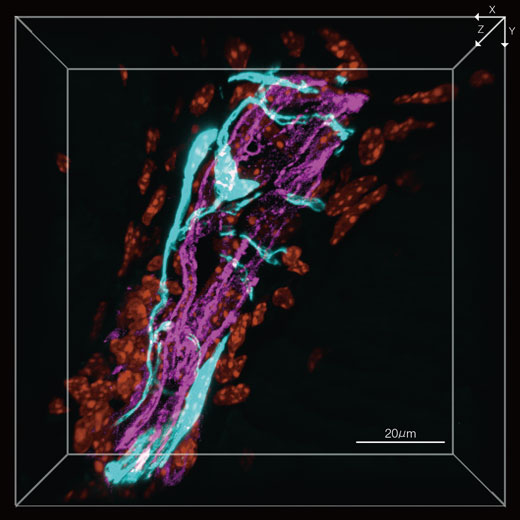Discovering Fine Neurovascular Structures in Tibial Epiphysis Using the FLUOVIEW FV3000 Microscope
Imaging of Fine and Complex Tissue Structures while Reducing Bleaching
Imaging blood vessels and sensory nerves in the epiphysis of a knee joint is difficult because the nerves and vessels form a complex structure within a narrow area. Owing to its high transmission efficiency, the FLUOVIEW FV3000 confocal laser scanning microscope enables bright, high-resolution imaging of fine structures while using low laser power, which helps reduce photobleaching in the sample. Using this capability of the FV3000 microscope, we were able to successfully image a complex 3D structure of sensory nerves and their surrounding vasculature penetrating a foramen in the tibial epiphysis.
| Related Videos |
Figure 1: Sensory nerves and surrounding vasculature penetrate a foramen in the tibial epiphysis (3D image)
Sensory nerves (EYFP, cyan), blood vessels (Alexa Fluor 594, magenta), nuclei (DAPI, orange)
Imaging equipment
Microscope: FLUOVIEW FV3000 System
Objective: 100X oil immersion objective (UPLSAPO100XO)
Discovery of Neurovascular Structures in Tibial Epiphysis
Understanding the vascular and neural projections to the knee joint is important for relieving pain in knee arthropathy. However, until now, researchers have been unable to fully observe the fine structures formed by sensory nerves and blood vessels throughout the knee joint. With the FV3000 microscope, these structures are clearly visible for the first time. We observed that sensory nerves in the knee joint exist not only in the meniscus, but also in the tibial epiphysis. These sensory nerves are entwined with surrounding blood vessels, and together the neurovascular structure penetrates a foramen in the tibial epiphysis.

Figure 2:Neural and vascular foramen
How the FV3000 Confocal Microscope Facilitated Our Experiment
Highly Sensitive TruSpectral Detector Performs Imaging with Low Phototoxicity

The TruSpectral detector is equipped with a transmission-type diffraction grating that can transmit fluorescent signals with more than 40% higher efficiency compared to conventional reflection-type diffraction gratings. Because of the enhanced tranmission, less laser power is needed to acquire images, thus reducing phototoxicity.
Acquire High Signal-to-Noise Ratio Images under Low Excitation Light

The GaAsP photomultiplier tube (PMT) incorporates up to 4 channels with a maximum quantum efficiency of 45%, enabling users to view samples that were too dim to view with conventional equipment. Peltier cooling reduces background noise by 20% for high S/N ratio images under exceptionally low excitation light.
Comment by Dr. Katsuhiro Kawaai
 | To image the fine and complex 3D structure of neurites in a narrow area, a 100X oil immersion objective with a high numerical aperture (NA) was required; however, bleaching caused by concentrated laser power was a concern. Fortunately, owing to the high sensitivity of the FV3000 microscope, we were able to keep laser power low while obtaining high-resolution images from 50 Z planes at 0.45μm intervals without photobleaching our sample. |
Acknowledgments
This application note was prepared with the help of the following researchers:
Dr. Katsuhiro Kawaai and Dr. Koichi Matsuo, Laboratory of Cell and Tissue Technology, Keio University School of Medicine
Products Related to This Application
was successfully added to your bookmarks
Maximum Compare Limit of 5 Items
Please adjust your selection to be no more than 5 items to compare at once
Not Available in Your Country
Sorry, this page is not
available in your country.
